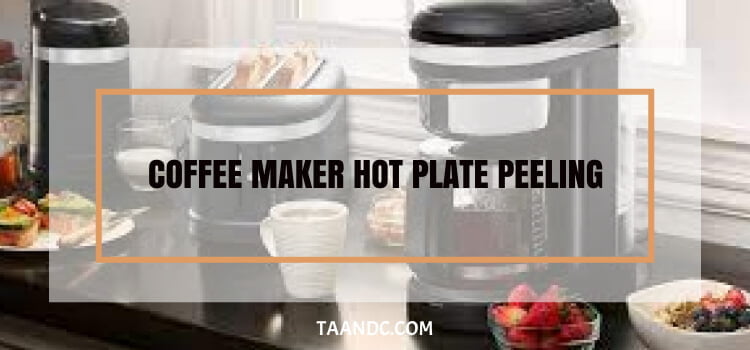If you’re anything like me, your day begins with that comforting aroma of freshly brewed coffee. Ah, that first sip! But fellow coffee enthusiasts, let me tell you about a not-so-invigorating wakeup call I had – the dreaded coffee maker hot plate peeling issue. It may not sound like a big deal, but it can damper your mornings when your beloved coffee companion starts showing signs of wear and tear. In this little corner of the internet, I’m here to share my experiences and tips on how to keep that trusty coffee maker’s hot plate in top-notch shape. Let’s ensure your daily brew remains a delightful ritual, peeling-free!

Understanding Coffee Maker Hot Plates
When it comes to coffee makers, most of us are fixated on the quality of the coffee beans and the brewing process, often overlooking a crucial component that plays a significant role – the hot plate. In this section, we’ll delve into the world of coffee maker hot plates to understand their types, their importance, and the common materials used in crafting these essential elements.
Types of Coffee Maker Hot Plates
Coffee maker hot plates come in various types, each with unique characteristics and advantages. The two primary types are:
- Glass Hot Plates: These are the most common type, often found in drip coffee makers. Glass hot plates are known for their even heat distribution, preventing coffee from scorching. They are durable and easy to clean, making them a popular choice among coffee enthusiasts.
- Metal Hot Plates: Metal hot plates are typically found in espresso machines and some percolators. They heat up quickly and are highly efficient at keeping coffee hot. However, they can sometimes cause coffee to taste slightly metallic if improperly maintained.
Importance of Hot Plates in Coffee Makers
The hot plate is the unsung hero of your coffee maker. Its role is vital for several reasons:
- Temperature Maintenance: Hot plates keep your freshly brewed coffee at an optimal temperature, ensuring it remains hot and enjoyable until you’re ready to savor it.
- Extended Freshness: Hot plates help preserve the flavors and aroma of coffee by preventing it from cooling too quickly, giving you a consistently delightful cup of coffee.
- Convenience: The hot plate allows you to brew a coffee and return for a refill without reheating it.
Common Materials Used for Hot Plates
Manufacturers use various materials to create coffee maker hot plates, each with its unique characteristics:
- Ceramic: Ceramic hot plates are known for their excellent heat retention and even distribution. They are less likely to scorch coffee and are easy to clean.
- Stainless Steel: Stainless steel hot plates are durable, resistant to corrosion, and can withstand high temperatures. They are often used in commercial coffee makers.
- Nonstick Coatings: Some hot plates feature nonstick coatings, which make them easy to clean and prevent coffee residue from sticking.
Understanding the types and importance of hot plates and the materials used is essential for coffee lovers who want to enjoy a consistently excellent cup of coffee from their trusted coffee maker. In the next section, we’ll explore the potential issues that can arise with hot plates, particularly the annoying problem of peeling.
Causes of Hot Plate Peeling
Your trusty coffee maker’s hot plate might show signs of wear and tear; if it does, you’re not alone. Hot plate peeling is a common issue that can disrupt your morning coffee routine. Let’s explore the key causes of this annoying problem so that you can better understand and address it.
High-Temperature Exposure
Prolonged exposure to high temperatures is one of the primary culprits behind hot plate peeling. Coffee makers operate at elevated temperatures to keep your brew warm. Over time, this constant heating and cooling cycle can cause the hot plate’s surface to deteriorate. You might notice small cracks or areas where the coating starts to peel off. This issue is more prevalent in lower-quality coffee makers that lack adequate temperature control mechanisms.
Water & Moisture Damage
Water and moisture are the mortal enemies of most materials, and hot plates are no exception. Moisture exposure is a regular occurrence for coffee makers, whether from spilled water during the brewing process or from the humidity in your kitchen. “If your coffee maker’s hot plate isn’t adequately sealed or protected, water can seep into the layers, causing the material to swell and, eventually, peel.” This is why cleaning and drying your coffee maker thoroughly after each use is essential.
Poor Quality Materials
Quality matters when it comes to coffee maker hot plates. Some manufacturers may cut corners by using subpar materials or coatings that aren’t designed to withstand the rigors of daily use. When investing in a coffee maker, choosing one with a reputable brand known for using high-quality materials is crucial. While it might cost a bit more upfront, it can save you from the headache of dealing with hot plate peeling down the road.
Aging & Wear
As with any appliance, age and wear play a significant role in the deterioration of your coffee maker’s hot plate. Over time, the constant exposure to heat, moisture, and the daily grind of brewing coffee can take its toll. Even the best-quality hot plates will eventually show signs of aging. Regular maintenance, such as cleaning and descaling, can prolong their lifespan, but it’s essential to be prepared for the eventuality of needing a replacement if you’re a devoted coffee enthusiast.
Understanding these causes of hot plate peeling is the first step toward preventing or addressing the issue. In the next section, we’ll explore proactive steps you can take to keep your coffee maker’s hot plate in optimal condition and enjoy your morning coffee without any unwelcome surprises.
Preventing & Addressing Hot Plate Peeling
Nobody wants to wake up to the unpleasant surprise of a peeling hot plate in their coffee maker. Fortunately, there are proactive steps you can take to prevent hot plate peeling and address it if it does occur. Let’s explore some practical solutions to keep your morning brew hassle-free.
Regular Maintenance & Cleaning
The importance of regular maintenance and cleaning cannot be overstated. After each use, make it a habit to clean your coffee maker thoroughly. Remove coffee residues and mineral deposits by descaling the hot plate and other parts as your coffee maker’s manual recommends. Use a soft cloth to wipe the hot plate gently, avoiding abrasive materials that could scratch the surface.
Using Quality Coffee Makers
Investing in a high-quality coffee maker from a reputable brand can significantly reduce the risk of hot plate peeling. Look for models with well-constructed hot plates, and read reviews to ensure they have a track record of durability. While it may cost a bit more upfront, it can save you from the frustration. This frustration arises from having to replace or repair your coffee maker prematurely.
Temperature Control
Proper temperature control is crucial for preventing hot plate peeling. Avoid leaving your coffee maker’s hot plate on for extended periods when not in use. Most modern coffee makers have an automatic shutoff feature. This feature turns off the hot plate after a certain amount of time. Utilize this feature to prevent excessive heating and potential damage to the hot plate.
DIY Repairs vs. Professional Assistance
If you notice signs of hot plate peeling, consider your options carefully. This sentence is already in active voice, and changing it to passive voice would make it less clear and concise. For example, you might be able to remove loose bits of coating and apply a food-safe epoxy to seal any exposed areas. However, if the damage is extensive or affects the hot plate’s functionality, it’s advisable to seek professional assistance or contact the manufacturer for guidance.
Replacement Options
In cases where hot plate peeling becomes irreparable or severely compromises your coffee maker’s performance, be prepared for replacement options to be explored. While it might be disappointing to part ways with a beloved appliance, a new coffee maker with an intact hot plate will ensure you continue to enjoy your daily brew without any hiccups. By following these preventive measures and being proactive in addressing hot plate peeling, you can extend the lifespan of your coffee maker.
FAQ
Why is the hot plate on my coffee maker peeling?
The hot plate on your coffee maker may be peeling due to wear and tear over time or exposure to moisture.
Is a peeling hot plate on my coffee maker safe to use?
A peeling hot plate can potentially pose safety risks, so it’s advisable to discontinue using the coffee maker and address the issue.
How can I prevent the hot plate on my coffee maker from peeling?
Avoid using abrasive cleaning materials to prevent peeling and ensure the hot plate stays dry between uses.
Can I repair a peeling hot plate on my coffee maker?
In some cases, you may be able to repair a peeling hot plate, but it’s often more practical to replace it or seek professional assistance.
Where can I find replacement hot plates for my coffee maker?
You can typically find replacement hot plates for your coffee maker through the manufacturer’s website, authorized dealers, or online appliance parts retailers.
Conclusion
Ensuring the durability and quality of your coffee maker is essential to avoid issues like hot plate peeling. Investing in a reputable brand with a track record of reliable products can help you avoid such problems. Regular maintenance and cleaning can also extend the lifespan of your coffee maker, preventing issues like peeling. Remember to read product reviews and specifications carefully before purchasing to ensure you’re getting a high-quality coffee maker that will serve you well for years, without worrying about hot plate peeling.



